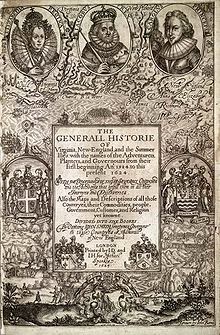 |
| John Smith wrote one of the first histories of Burmuda. |
Bermuda
Colonized 1609
It wasn't exactly
intentional, you understand. A flotilla of ships belonging to the Virginia
Company, headed for Jamestown and carrying the new Governor, encountered a
dreadful storm at sea -- probably a hurricane. The Sea Venture, the flagship
of the flotilla, was under the command of Admiral George Sommers, who
deliberately wrecked the ship on a reef in order to avoid foundering in open
sea. The reef turned out to be attached to the island of Bermuda.
Bermuda was not unknown
at this time. It had been discovered over a hundred years earlier, and was used
by both the Spanish and the Portuguese as a place to replenish meat and water
supplies. The island, however, was thought to be haunted and was known as the
"Island of Devils." Its bad reputation probably sprang from the
treacherous reefs surrounding it, the almost-constant sound of wind and storms,
and the odd noises heard in the night (birds, wild hogs, and the storms.)
The crew and passengers
of the Sea Venture made it safely to land: 150 people and one dog. Over
the next 10 months they built two new ships, and in 1610 most of the castaways
sailed for Virginia. They left several people on Bermuda to establish the claim
for England. Today, Bermuda's capital, St. George's, is the oldest continuously
inhabited town in the Western Hemisphere.
Among the individuals
wrecked on Bermuda are two noteworthy individuals. The first is William
Strachey, whose written report of the shipwreck is thought to have been one of
the sources of Shakespeare's The Tempest. The other is John Rolfe, who
later made his way to Jamestown, where he became the husband of Pocahontas.
 |
| John Rolfe was one of the shipwreckees. Here he is at the baptism of his future wife, Pocahontas. |
 |
Charles Boycott was a most unpopular man. |
Birth of Charles Cunningham
Boycott, 1832
Have you ever wondered
where the word "boycott" came from? Charles Boycott was an Englishman
who served as land agent for Lord Erne, who owned much of the property in County Mayo, Ireland. As land agent, his job was
to collect rents from Lord Erne's tenants. Boycott was already unpopular among
the tenants: he had a reputation for fining people for minor offenses, such as
leaving gates open, or allowing chickens to trespass on his property.
1880 had been a poor
year in terms of harvests, and Lord Erne had agreed to a 10% reduction in
rents. The tenants, however, wanted a 25% reduction. Boycott forwarded the
tenants' demands to Erne, who refused them. Boycott then began eviction
proceedings for those who had not paid their rent.
It was at about this
time that the Irish Land Movement had begun to become powerful. Headed by such
men as Charles Parnell and Michael Davitt, the movement strove to reduce land
rents and stop evictions, and ultimately, to allow tenant farmers to become
owners of the lands they tilled.
It was a bad time to try
to evict tenants. The locals began by evading and threatening those serving the
eviction notices. They then began threatening Boycott's servants and advising
them to leave his employ. The blacksmith, laundress, and postal carriers were
next to boycott Boycott, and pretty soon the shopkeepers had stopped serving
him as well. Boycott had no help to harvest his own crops, and was bringing his
own supplies in by boat from a distance.
In October of 1880,
Boycott wrote a letter to The Times outlining his situation. After his
situation became known outside of County
Mayo, the newspapers
became involved, and soon The Boycott Relief Fund was organized to help
Boycott harvest his crops.
Fifty Orangemen came in
from County Cavan
and County Monaghan to harvest Boycotts crops, and
were protected by 1000 men from the Royal Irish Constabulary. It is estimated
that it cost the British government and various donors over £10,000 to harvest
£350 worth of potatoes.
No comments:
Post a Comment